Shugborough, the Rosicrucians
and the Masonic Society
Sept. 15, 2004
(Updated May 2023)
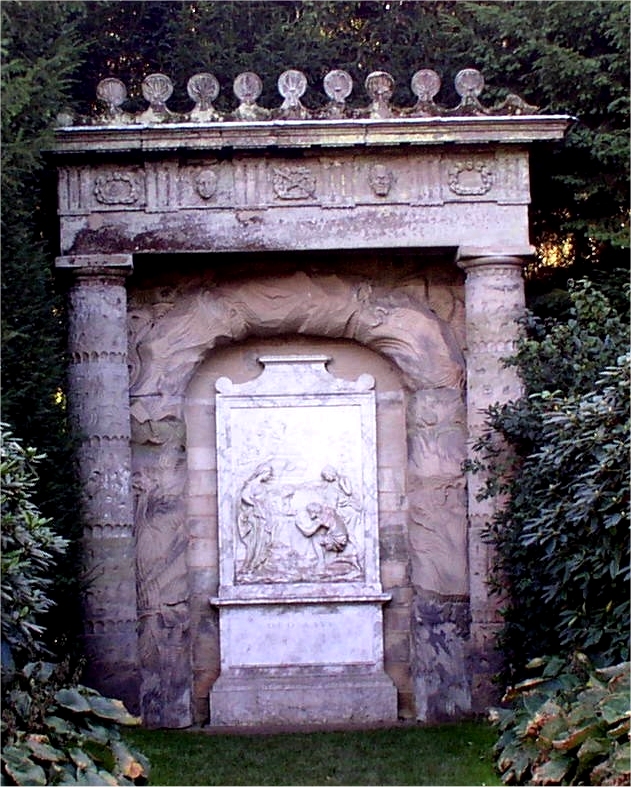 Shepherd's Monument ©Shannon Dorey |
The code on the Shugborough Shepherd's monument at Staffordshire in Lichfield, England has been confusing theorists since it was first created in the 1760s. Rumours say the secret letters on the monument are "hiding a set of instructions on how to find the Holy Grail, the chalice in which the blood of Jesus was collected, as it fell from his crucified wounds."http://www.bbc.co.uk/stoke/content/ articles/2005/05/17/ shugborough_code _ feature.shtml Helen Thomas My research on the African Dogon religion ties the monument to the alien fish and serpent like Nummo, the Rosicrucians and the Masonic Society.
The letters on the Shugborough monument at Staffordshire in Lichfield, England, which is found on the grounds at Shugborough Hall, the seat of the Earls of Lichfield, likely identify an Operative Masonic altar. I believe that the secret Operative Masonic society associated with the monument was a group that had been started by the Rosicrucian and alchemist, Elias Ashmole. He had been born in Lichfield, Staffordshire, England, 23 May 1617, and died in South Lambeth (London) in 1692.http://freemasonry.bcy.ca/ texts/EliasAshmole.html Grand Lodge of Yukon and British Columbia. Elias Ashmole
Alchemy is linked to these groups because my research associates it with the lost science of the Nummo. In the Dogon religion, the four alchemical symbols, fire, water, earth and air were identified with the development of the world.The Nummo, Shannon Dorey p. 32. They were considered the key elements of the Milky Way Galaxy and associated with the regeneration of life and the four directions of space.The Rose, Shannon Dorey pp.71- 72.
My research associates this knowledge with the Merovingians, the Cathars and others, whose beliefs were considered heretical by the Roman Catholic Church. It is likely that the Rosicrucians and the Masonic Society were formed as a way for these outlawed sects to practise their religion under the nose of the Church. The Shugborough monument, which I believe was later built to create a meeting place for this group, was constructed in the 1760s long after Ashmole's death.
 Masonic Altarhttp://www.kena.org/hirams/ Pictures/ Masonic/York%20Rite/Chapter/ |
 1768 Masonic Altar |
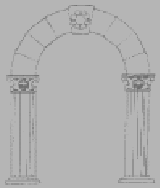 Masonic Altarhttp://www.kena.org/ hirams/Pictures/MasonicMasonic %20Backgrounds/ YRRAM%20Backgrounds |
 Masonic Altarhttp://www.kena.org/ hirams/Pictures/Masonic /York%20Rite/Chapter |
Compare these Masonic altars with the picture of the Shugborough monument, above. One of the altars is dated 1780. The Anson family built the Shugborough monument between 1761 and 1767http://priory-of-sion.com/ psp/id16.html Shugborough Hall. Paul Smith so this drawing is from the same time period.
My research makes a connection between the masonic hammer and the smith's hammer, which plays an important role in the Dogon religion. The Smith was a significant religious figure in the religion because the Nummo were known as "Heaven's Smiths." The Nummos' spaceship was known as a smithy, probably because it was seen to emit fire.Shannon Dorey, The Rose: Dogon Star Knowledge, pp. 59-61.
It was in the smithy that the Nummo carried out their experiments and it was in an objet identified with the Smith's hammer that all the seeds (DNA) came down from the Nummos' world to be reproduced on Earth. Shannon Dorey The Rose: Dogon Star Knowledge p. 70.
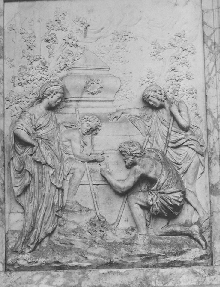 Shepherd's Monument ©Shannon Dorey |
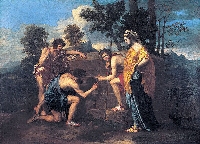 Les Bergers d'Arcadie (The Shepherds of Arcadia)http://en.wikipedia.org/wiki/File: Nicolas_Poussin_052.jpg The Yorck Project: 10.000 Meisterwerke der Malerei. DVD-ROM, 2002. ISBN 3936122202. Distributed by DIRECTMEDIA Publishing GmbH. |
The Masonic altar at Shugborough was designed in reverse to Poussin's "Les Berger d'Arcadie" (Shepherds of Arcadia) which was painted in 1637-39. My research in The Rose: Dogon Star Knowledge associates Poussin with the Masonic society. It is the reversal of Poussin's painting to that of the monument that is the key to solving the letters found on the altar. The painting indicates the letters are supposed to be read in reverse.
Not only are the letters on the Shugborough monument reversed according to Poussin's painting, but the top letters are separated from the bottom letters because the top letters are also meant to be flipped. The clues for this are found in the Church at Rennes le Château in the south of France, which was also associated with the Masonic Society, the Merovingians and the Rosicrucians. I believe that this was another meeting place for those who practised the outlawed pagan religion associated with these groups.
 ©Shannon Dorey 2004 ©Shannon Dorey 2004 |
When flipped and reversed the top letters on the Shugborough monument spell MAVSONO.
In the early 1970's the actual tomb, which appears in Poussin's painting of the Shepherds monument, was discovered on the outskirts of Arques approximately six miles from Rennes le Château.Michael Baigent, Richard Leigh and Henry Lincoln p.39. There are various clues to deciphering the Shugborough monument found at the church at Rennes le Château.
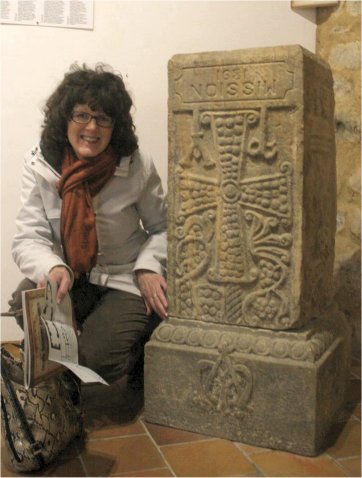 Shannon Dorey with Pillar©Robert Hill 2005 |
For instance the original Visigothic Pillar that used to support the old altar was displayed upside down in the church as is shown in this picture of me beside the pillar in 2005.
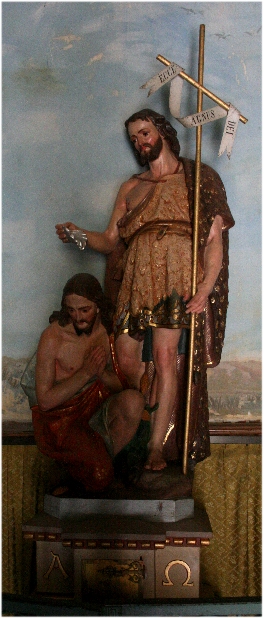 © Robert Hill 2011 |
Another clue found in the church is a statue of Jesus being baptized by John where two upside down "Vs" are seen hanging from John's cross to form the letter "M", shown above.
 Letters on Shugborough Monument ©Shannon Dorey |
The clues found at Rennes le Château may have been part of a Masonic ritual which had initiates identifying the meaning of the letters on the Shugborough monument. The second letter "A" and the third letter "V" represent the Masonic symbols of the compass and the square, which are meant to appear overlapping each other as shown below. Aside from the fact they represent the Masonic symbols, together they provide the "A" for the word MASON.
The clue that these Vs should overlap also appears at Rennes le Château, where they are engraved in stone in the word OMARIE. The A in the name MARIE is overlapped by an M. It is part of a phrase meaning "Oh Mary Conceived Without Sin Pray For Us." Henry Lincoln, one of the authors of Holy Blood/Holy Grail and the author of The Holy Place, a book about Rennes le Château, says it almost appears as if the stone mason who carved the phrase and the name MARIE made a mistake, first putting in the MM and then overlapping the second M with an A.Henry Lincoln's Guide to Rennes le Château. DVD. 2000. Illuminated Word. 2005. The Disinformation Company Ltd. Lincoln joked that he thought this was highly unlikely because the M's are written like upside down V's. The overlapping letters in the stonework are clearly the Masonic symbol.
The letter "O" in the word OMARIE may also be a clue since the letter "O" at the beginning of the word OMARIE is reversed to the letter "O" at the end of the word MASONO on the Shepherd's monument. The Demon Asmodeus, who appears at the entrance to the Church at Rennes le Château, also holds his right hand in the shape of a letter "O." This "O" may also be identified with the Omega symbol, which also appears along with the Alpha symbol, which means the beginning and the end, beneath the statue of Jesus and John, shown above.
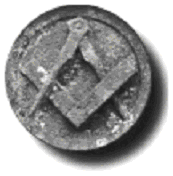 http://www.kena.org /hirams/Pictures /Masonic/Square%20&%20Compasses /SQC79.jpg Kena Hiram's Masonic Picture Collection. |
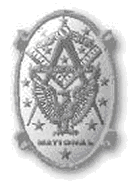 http://www.kena.org/hirams/ Pictures/Masonic/ National%20Sojourners/ Kena Hiram's Masonic Picture Collection. |
These two pictures show how the compass and square appeared on Masonic artefacts supporting the theory that these two letters were meant to be read over lapped.
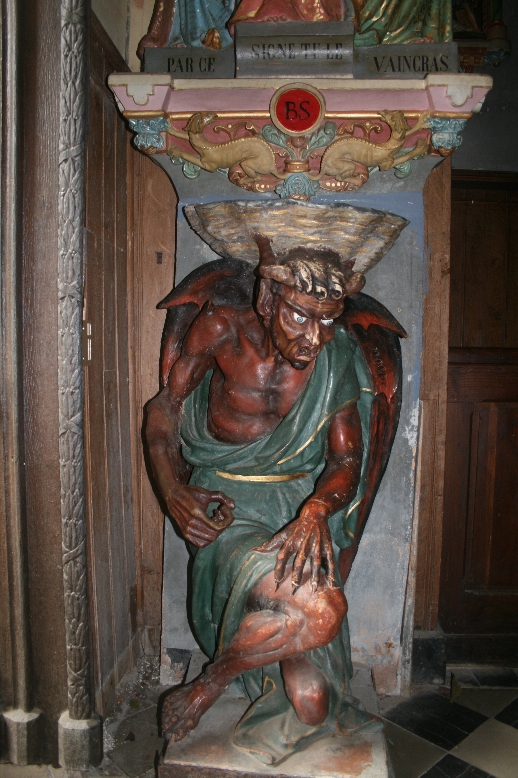 Asmodeus at Entrance to the Church at Rennes le Château ©Robert Hill |
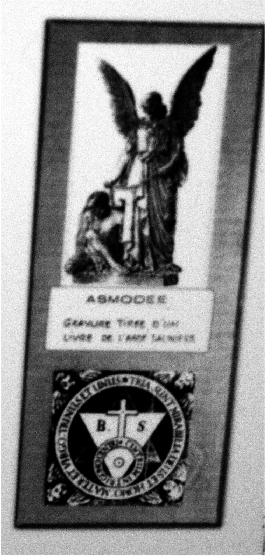 ©Robert Hill 2011 |
Another clue, for these "Vs" being read overlapped, is found in the museum at Rennes le Château where Asmodeus appears again in a framed picture of two triangles overlapping each other on a bookplate. Asmodeus appears on top, and the picture of the overlapping triangles appears below him.http://www.consciousevolution.com /Rennes/curious.htm Simon Miles
This is a clearer picture of the overlapping triangles.
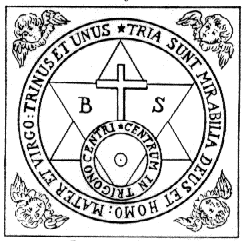 |
According to Simon Miles, the picture of the overlapping triangles or hexagram representing the Masonic "Vs", was thought to have been created by Berenger Saunière, who became the parish priest at Rennes le Château in 1885. The letters "BS" appear on the picture of the triangles, which is why it was assumed the drawing had been created by Berenger Saunière. As Miles points out, however, the picture of the triangles on the framed book plate is actually the frontpiece to Heinrich Madathanus "Aureum Seculum Redivivum," or "The Golden Age Revived," first published in Frankfurt in 1625. Madathanus was the pseudonym of Adrian von Mynsicht (1603-1638), an alchemist, esotericist and apologist for the Rosicrucians.http://www.consciousevolution.com /Rennes/curious.htm Simon Miles This is important because of Elias Ashmole's relationship to the Rosicrucians and the fact he was also an alchemist. Above is the picture of the overlapping triangles that was found on the bookplate and on the frontpiece to Heinrich Madathanus "Aureum Seculum Redivivum," or "The Golden Age Revived." Notice the four angels on the bookplate, they also appear in the church entrance above Asmodeus.
"The Golden Age Revived" may be associated with Millenarism, which I refer to in The Rose: Dogon Star Knowledge. It is basically associated with the Second Coming and the establishemnt of the Kingdom of God on Earth, which is suposed to last a thousand years or more (a milleniuum). One of the books that promoted the philosophy was the Romance of the Rose.Dorey, The Rose: Dogon Star Knowledge pp. 360-361
Miles pointed out that the symbol of the overlapping triangles is also prominently displayed on a monument in Rome, Italy, known as the Porta Alchemica, or "Alchemical Door." This door was covered in hermetic and alchemical symbols and quotations. It can be found in the walls of the Villa Palombara, located in the Piazza Vittore Emmanuele and was built around 1680 by the Marquis Massimigliano Palombara.http://www.consciousevolution.com /Rennes/curious.htm Simon Miles On top of the centre of the archway of the Italian "Alchemical Door" is a head not unlike the head that appears on top of the Shugborough monument. There is also the bottom of a wreath that appears around the circle above the "Alchemical Door".
 |
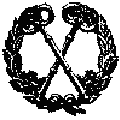 http://www.kena.org/ hirams/Pictures/Masonic/ National%20Sojourners/l http://www.kena.org/ hirams/Pictures/Masonic/ National%20Sojourners/l |
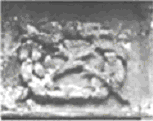 |
Wreaths appear on the top of the Shugborough monument as well. On the two drawings of the Masonic altars (shown earlier) a circular wreath appeared at the top centre on the keystone. These wreaths resemble a close up of the wreath on the top of the Shugborough monument above. A second wreath appears in the centre of the Shugborough monument above the keystone (bottom image). Compare it to the Masonic symbols of the keys and wreath above middle. They form an "X" which is also associated with the Masonic crossbone. A similar wreath also appears on the Original Visigothic Pillar that used to support the old altar in the church at Rennes le Château.
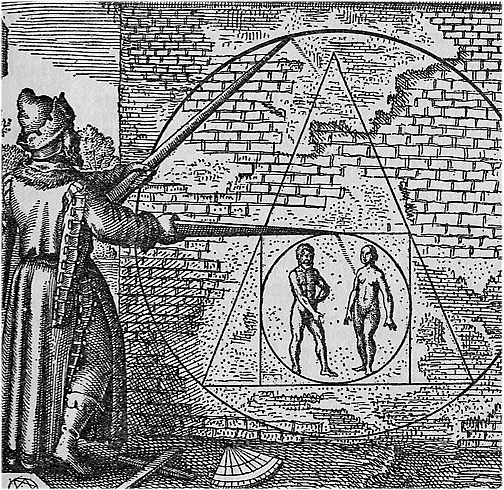 Michael Maier Emblem 21 Atalanta Fugienshttp://en.wikipedia.org /wiki/File:Michael_Maier_ Atalanta_Fugiens_Emblem_21.jpeg |
The symbol from the "Alchemical Door" was also compared by Mino Gabriele to the 21st emblem of Michael Maier's Atalanta Fugiens, which is another alchemical manuscript published in Frankfurt in 1617. In the picture a man with a pair of compasses is in the process of constructing the overlapping triangles or hexagram by drawing a triangle within a larger circle.http://www.levity.com/alchemy /queen_christina.html Susanna Akerman, Christina of Sweden 1626-1689. the Porta Magica and the Italian Poets of the Golden and Rosy Cross. Inside the triangle is a smaller circle and inside the circle is a picture of Adam and Eve. The compasses in the picture reiterate the hexagram's or the overlapping triangles' connection to the Masonic Society. An image resembling a sea shell also appears in the foreground of the picture emphasizing its association to the Merovingians and the Nummo. A 1656 English translation of Maier's Themis Aurea appeared as Themis Aurea: The Laws of the Fraternity of the Rosie Cross, and was dedicated to Elias Ashmole,http://en.wikipedia.org/ wiki/Michael_Maier providing another connection between Elias Ashmole and Rennes le Chateau.
My research in The Master (Mistress) of Speech, reveals that the two V symbols, which are associated with the compass and square in Masonic symbolism, represent chromosomes. In the Dogon religion, the V’s were also represented by keys, another Masonic symbol. In genetics, duplicated chromosomes form an X shape, which the Dogon described as Amma forming two points. It recalled the formation of the double placenta. The V symbol was also known as Amma's Door, which may associate it with the alchemical door.Dorey, The Rose: Dogon Star Knowledge p.70
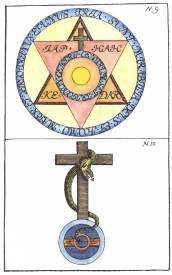 Donum Deihttp://www.levity.com/ alchemy/amcl_eleazar.html">© Adam McLean |
The picture from the front piece of the "Aureum Seculum Redivivum" appears yet again in another alchemical work entitled, Donum Dei by Simon Baruch, drawn by Adam McLean. A book by Abraham Eleazar entitled, "Uraltes chymisches Werck", Erfurt, 1735, displayed Simon Baruch's engravings.http://www.levity.com/ alchemy/amcl_eleazar_donum.html Adam McLean
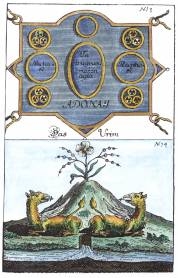 http://www.levity.com/ alchemy/amcl_eleazar.html">© Adam McLean |
In Eleazar's book, known as the book by Abraham the Jew, is another picture by Simon Baruch of two salamander type beings and a hill with what appears to be a rose growing from it. The rose was the symbol of the Rosicrucians. It was also drawn by Adam McLean. These salamanders and rose also appear in the church at Rennes le Château just above Asmodeus as seen in the previous picture. The importance of this is that salamanders are amphibians just like the Nummo. The Nummo were described as being like serpents associating them with the picture on the left. Because sunlight was believed to be harmful to them, the Nummo spaceship resided underground. From the surface, it looked like a giant anthill just like the picture above.
 Statue at Rennes le Château ©Robert Hill |
All of these pictures were combined to create the statue found at the entrance to the church at Rennes le Château, which was built under the direction of the parish priest, Berenger Saunière. On the statue, above Asmodeus and the salamanders, are four angels. This is of course flipped to the framed picture in the museum of Asmodeus on the top, and the cover of the "Aureum Seculum Redivivum" with the overlapping triangles in the middle and the four angels, one in each corner, on the bottom. On the statue, the rose is in the centre of the cross above the angels. The rose and cross were the symbols of the "Rosy Croix" or Rosicrucians. The letters "BS" from the cover of the "Aureum Seculum Redivivum" also show a reversal of the initials of Simon Baruch who created the two pictures shown above and found in the book by Abraham Eleazar (Abraham the Jew). The statue's location at the entrance of the church is important because it ties it to the "Alchemical Door".
As Henry Lincoln pointed out, the statue is also revealing the four elements. Fire is associated with the mythical salamanders that were born out of fire. The alien Nummo were associated with fire and their spaceship was identified with a smithy. They were also hermaphrodites and because of this, they were always depicted as twins associating them with the dual salamanders. The Nummo spent more time in water than on land and as Lincoln pointed out, water is related to the water stoop in the form of the shell over the devil's head, the angels are identified with air, and the devil was known as Rex Mundi, who was Lord of the Earth.Henry Lincoln's Guide to Rennes le Château. DVD. 2000. Illuminated Word. 2005. The Disinformation Company Ltd. Tapestries of the four elements once hung in the house at Shugborough but only one remains. It is of "Earth" and was probably woven by John Vanderbank at the Soho Manufactory in London in the early 1700s. "It is closely based on a panel of the Gobelins Elements, designed by Le Brun a generation earlier."The National Trust, Shugborough, John Martin Robinson. 1989. Reprinted 1998. The tapestry of the Element "Earth" was hanging in the staircase hall when I was there in 2005.
On the Shugborough monument, the letters "SON" spell the end of the word "MASON". The letter "O" at the end of the word and mentioned earlier, may also stand for "Operative" a form of Freemasonry. "Operative" was a term that was used to refer to working masons. I believe the term also became identified with mathematicians and scientists in the 1600s. Elias Ashmole was supposed to have been the first Operative Mason of any consequence.http://www.blavatskytrust.org.uk/ html/articles/ the%20right%20angle%20p2.htm From the Theosophical Writings of H.P. Blavatsky compiled by Geoffrey Farthing.
In extracts from the Theosophical Writings of H.P. Blavatsky, it was reported that Elias Ashmole was admitted to the freedom of the Operative Masons' company in London in 1646. Blavatsky further reported that Elias Ashmole, was the celebrated antiquarian, who founded the museum of Oxford and was initiated together with Colonel Mainwarring in the Brotherhood of the working Masons in Warrington. She recounted how "the entrance of such men as Elias Ashmole into the Operative Fraternity paved the way for the great 'Masonic Revolution of 1717', when SPECULATIVE Masonry came into existence."http://www.blavatskytrust.org.uk/html /articles/the%20right%20 angle%20p2.htm From the Theosophical Writings of H.P. Blavatsky compiled by Geoffrey Farthing.
In A Chronology of the History of Freemasonry it was reported, "In this year, of 1646, a company of Rosy Croix that had been formed in London according to the ideas of Bacon's New Atlantis, assembled in the conference room of the Masons. Elias Ashmole, who was a member, and the other Brothers of the Rosy Croix, rectified the formulas of reception of these workmen, which consisted of some ceremonies similar to those used among all the professionals, and substituted a mode of initiation which they copied, partly, from the old mysteries of Egypt and Greece."http://members.optusnet. com.au/skyecn/althory.htm Translation Stuart Nettleton 1999. A Chronology of the History of Freemasonry.
It is in fact Greek mythology that plays a role in deciphering the bottom letters on the monument "D M". These letters which when reversed, like Poussin's painting, spell MD, meaning medical doctor. Ashmole was an M.D., Oxford had conferred the title of M.D. on him in 1669.http://freemasonry.bcy.ca/texts /EliasAshmole.html Grand Lodge of Yukon and British Columbia. Elias Ashmole.
The symbol for the medical profession is the symbol of the caduceus, which is related to Hermeticism and the Greek god Hermes. Hermes plays a significant role in the mythology of the Masons. He is also associated with the Jackal and the Smith from the Dogon religion. He is the god of thieves and thieving is an important theme in the Dogon religion. The Jackal stole fire from the Nummo's workshop in the same way that Hermes stole the 50 immortal cows from the sun god Apollo. In the Dogon religion fire symbolizes the spiritual essence of the Nummo. Both the cow and the sun were also symbols of the Nummo. This means that the immortal cows that Hermes stole represent the same thing as the stolen fire. It is identified with the genetic make-up of the Nummo and represents those souls lost to the Earth. The stolen fire represents the stolen DNA.
Hermes, who also plays a significant role in the mythology of the Masons, was one of the alchemical images circulating during the Middle Ages and the Renaissance. The name Hermes is part of the word "Hermaphrodite," and androgynous and hermaphroditic figures also play a role in Masonic, Dogon, and alchemical mythology. I believe that the caduceus Hermes carries is a symbol for DNA. The alien Nummo, who I believe are at the root of all of these beliefs, were hermaphrodites.
Refer to my blog post on Anubis and the Jackal for information on Hermes and the Dogon religion.
For more information on the Dogon religion refer to my books, The Master (Mistress) of Speech, The Nummo, Day of the Fish and The Rose.